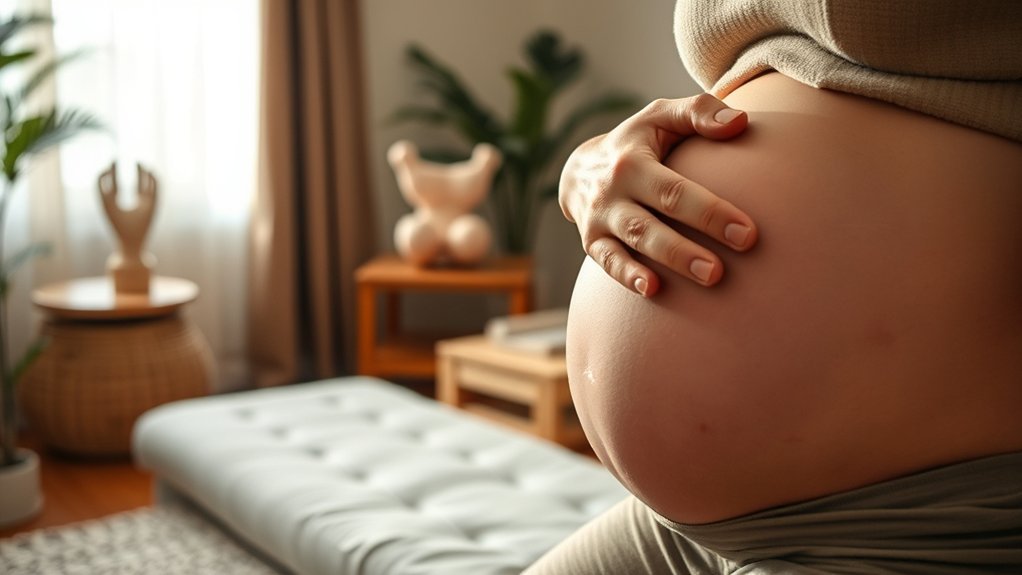As a new parent, you might not realize how essential your pelvic floor recovery is for your overall well-being. It affects not just your physical health but also your emotional state and family dynamics. Issues like urinary incontinence or pelvic pain can be common, yet they don’t have to define your experience. Understanding the signs and seeking appropriate rehabilitation can help you regain control. Let’s explore what steps you can take to support your recovery journey.
Understanding the Importance of the Pelvic Floor for Parents
The pelvic floor is an essential support system for your body, especially after childbirth. It supports key pelvic organs, including the bladder and uterus, playing a fundamental role in maintaining urinary and bowel control.
The pelvic floor is vital for your body’s support, particularly after childbirth, ensuring urinary and bowel control.
Unfortunately, many parents experience pelvic floor dysfunction (PFD) due to the physical changes during pregnancy and delivery. You might find that urinary incontinence affects you, with studies showing it impacts 24%-42% of women during the third trimester.
Engaging in pelvic floor exercises can appreciably improve your pelvic floor health, enhancing muscle strength and coordination. Additionally, prioritizing postpartum care, including early access to postpartum mental health therapy, is imperative to addressing these issues and reclaiming your well-being. Don’t underestimate the importance of your pelvic floor in your recovery journey.
Common Pelvic Floor Issues Postpartum
After childbirth, you might experience common pelvic floor issues like urinary incontinence or pelvic pain, which can greatly impact your daily life.
These concerns affect many women and can be distressing, but you’re not alone in this journey. Understanding these challenges is the first step toward finding effective solutions and regaining your pelvic health. Additionally, increasing education regarding signs, symptoms, and treatment can empower you to seek the necessary help.
Incontinence After Childbirth
Experiencing incontinence after childbirth is more common than you might think, affecting around 24% to 42% of new mothers. Many women face pelvic floor disorders, including urinary and fecal incontinence, which can arise from the changes your body undergoes during pregnancy and delivery.
While some symptoms may resolve naturally, others can linger for years, greatly impacting your quality of life. Early intervention is essential; pelvic floor physical therapy can effectively reduce or eliminate incontinence symptoms, enhancing muscle coordination and strength.
It’s important to acknowledge the psychological strain that often accompanies these issues, as nearly half of pregnant women report distress from pelvic floor disorders.
Don’t hesitate to seek help; you’re not alone in this journey.
Pelvic Pain Concerns
While many new mothers focus on the joys of parenthood, it’s essential to recognize that pelvic pain can be an unwelcome companion during the postpartum period.
Up to 40% of women experience pelvic floor dysfunction, which can lead to discomfort in daily activities and intimacy. Conditions like pelvic floor myofascial pain, endometriosis, and levator ani syndrome may arise, impacting your quality of life.
Pelvic pain can persist for years, making early identification and treatment important. Engaging in physical therapy can effectively alleviate symptoms by enhancing muscle strength and coordination within the pelvic floor.
Additionally, addressing psychological factors, such as anxiety and depression, is critical for thorough pelvic health. Prioritizing your well-being is key to enjoying motherhood fully.
The Role of Pelvic Floor Rehabilitation
Pelvic floor rehabilitation plays an essential role in your recovery after childbirth, especially when addressing issues like urinary incontinence or pelvic pain.
Starting early, around six weeks postpartum, can greatly improve your long-term health and well-being.
Through personalized exercises and techniques, you can regain strength and function, setting a solid foundation for your recovery journey.
Importance of Early Intervention
Early intervention in pelvic floor rehabilitation is essential for new parents, as it can greatly mitigate the risk of long-term complications like stress incontinence and pelvic pain.
Starting around six weeks postpartum, addressing signs such as urinary incontinence or chronic pelvic pain can considerably improve your recovery outcomes.
Studies show that timely access to physical therapy can alleviate symptoms in 50% of women experiencing pelvic dysfunction.
By integrating pelvic floor rehabilitation into your postpartum care plan, you enhance not only your physical recovery but also your mental well-being.
Don’t wait to seek help; early intervention is key to preventing lasting issues and improving your overall quality of life as a new parent.
You deserve to feel your best.
Common Rehabilitation Techniques
Understanding the various rehabilitation techniques available can empower you on your journey to recovery.
Pelvic floor rehabilitation includes personalized treatment plans focusing on strengthening or relaxing your pelvic floor muscles. Common techniques involve Kegel exercises, which enhance muscle strength, and diaphragmatic breathing for relaxation.
Manual therapy can alleviate tension and improve muscle function, while electrical stimulation and biofeedback help you gain better muscle control and awareness.
Typically, rehabilitation begins around six weeks postpartum, even if you haven’t fully healed, to prevent complications like organ prolapse.
Collaborating with pelvic health physical therapists guarantees you receive a tailored care plan that addresses your specific needs and symptoms, guiding you toward effective recovery and improved pelvic health.
Long-Term Health Benefits
While many new parents focus on immediate postpartum recovery, investing in pelvic floor rehabilitation can yield substantial long-term health benefits.
Engaging in personalized pelvic floor therapy helps you reduce the risk of complications like urinary incontinence, pelvic organ prolapse, and chronic pelvic pain. Studies show that early intervention can lead to a 50-80% improvement in symptoms, enhancing your overall quality of life.
By focusing on muscle coordination and strength, you support your pelvic health and prevent future issues. Additionally, addressing pelvic floor dysfunction early can improve sexual function and reduce psychological distress, positively impacting your family dynamics.
Committing to pelvic floor strengthening exercises throughout life promotes sustained improvements in urinary and bowel control, ensuring lasting well-being.
Signs That Indicate the Need for Rehabilitation
If you’re experiencing symptoms like urinary or fecal incontinence, you’re not alone—these issues affect a considerable percentage of women during the third trimester of pregnancy and postpartum.
Prolapse sensations, such as heaviness or bulging in the pelvic area, can also indicate pelvic floor dysfunction and necessitate professional evaluation.
Chronic pelvic pain, which many postpartum women face, is another essential sign that suggests the need for rehabilitation.
Additionally, difficulty with bowel regularity or changes in sexual function after childbirth may signal underlying pelvic floor issues requiring intervention.
Early intervention is vital, as delaying rehabilitation can lead to long-term complications, including stress incontinence and muscle weakness, which can greatly impact your quality of life. Engaging in prenatal care can help prepare your body for the changes of childbirth and support recovery afterward.
Don’t hesitate to seek help.
Personalized Approaches to Pelvic Floor Therapy

Personalized approaches to pelvic floor therapy are essential for effective recovery, as each person’s journey and needs vary greatly.
A thorough initial assessment evaluates your unique symptoms and history, allowing your healthcare provider to tailor a rehabilitation plan just for you. This personalized therapy may include exercises like Kegels, manual therapy, and biofeedback, chosen based on your specific pelvic floor function and goals.
Integrating physical therapy principles into your routine helps reinforce clinical therapy at home, making pelvic floor awareness part of your daily life. Early intervention, ideally starting around six weeks postpartum, can prevent long-term complications. Additionally, collaboration among healthcare providers, including fetal specialists involved in the baby’s treatment, ensures that your care plan addresses all your needs, promoting a smoother recovery.
Techniques and Strategies for Effective Recovery
To guarantee a successful recovery of your pelvic floor, it’s crucial to incorporate a variety of techniques and strategies tailored to your needs. Here are three effective methods to contemplate:
- Pelvic Floor Exercises: Engaging in Kegel exercises can enhance muscle strength and control, alleviating urinary incontinence post-childbirth.
- Manual Therapy: Incorporating manual therapy techniques during rehabilitation can facilitate muscle relaxation, improving pelvic floor function and aiding recovery from childbirth trauma.
- Biofeedback and Electrical Stimulation: Utilizing these methods during therapy sessions helps you regain awareness and control over your pelvic floor muscles.
Consulting with physical therapists guarantees that your rehabilitation plan addresses both physical and emotional health aspects, leading to a thorough, personalized approach to recovery after pregnancy and childbirth. Additionally, understanding the importance of community involvement in maternal health initiatives can provide valuable support during your recovery journey.
The Emotional and Physical Benefits of Rehabilitation
While maneuvering the challenges of parenthood, prioritizing your pelvic floor rehabilitation can bring considerable emotional and physical benefits.
Addressing issues like urinary and fecal incontinence can vastly improve your physical health, especially since 24%-42% of women face pelvic discomfort during pregnancy and postpartum. Engaging in targeted physical therapy helps restore muscle strength and coordination, alleviating pelvic pain and enhancing your overall quality of life.
Additionally, effective treatment of pelvic floor dysfunction can greatly boost your emotional well-being, reducing psychological strain that affects nearly 48% of pregnant women. Specialized care for children is also an important aspect to consider, as it ensures that family health is prioritized during this crucial time.
Starting rehabilitation early, ideally 1-3 days postpartum, not only normalizes pelvic health but also strengthens family dynamics, empowering you to take on daily responsibilities with greater ease and confidence.
Long-Term Wellness: Preventing Future Pelvic Floor Issues

Prioritizing your pelvic floor health is crucial not just for recovery, but also for long-term wellness. By taking proactive steps, you can considerably reduce the risk of future pelvic issues.
Here are three essential strategies:
- Engage in pelvic floor exercises like Kegels to strengthen muscles and combat incontinence.
- Seek guidance from a pelvic floor therapist for personalized rehabilitation and to address any concerns early on.
- Adopt healthy lifestyle habits—stay hydrated, maintain a balanced diet, and stay active to support pelvic health. Additionally, be aware that certain substances, like liquid nicotine, can pose additional health risks and should be handled with care.
Educating yourself about pelvic floor health empowers you to seek timely care and fosters a supportive community, leading to improved quality of life and lasting wellness.
Your journey to long-term pelvic health starts today!
Frequently Asked Questions
How Long Does It Take to Heal Pelvic Floor Dysfunction?
Healing from pelvic floor dysfunction can take 6 to 12 weeks postpartum with proper rehabilitation. Early intervention, like physical therapy, greatly improves your recovery outcomes, so don’t hesitate to seek help if you’re experiencing symptoms.
How Long Does Pelvic Floor Recovery Take Postpartum?
Pelvic floor recovery postpartum typically starts around six weeks after childbirth. However, healing times vary widely; some may recover quickly, while others might experience symptoms for years without proper intervention. Early treatment can greatly improve outcomes.
Is Pelvic Floor Therapy Worth It Postpartum?
Yes, pelvic floor therapy’s definitely worth it postpartum. It helps you regain strength, reduce discomfort, and improve your overall well-being. Early intervention can make a significant difference in your recovery journey and quality of life.
What Emotions Are Connected to the Pelvic Floor?
Nearly 48% of pregnant women experience emotional distress from pelvic floor dysfunction. You might feel vulnerable, anxious, or frustrated due to symptoms like incontinence or pain, highlighting the importance of addressing both physical and emotional health.
Conclusion
In your journey of parenthood, prioritizing pelvic floor recovery isn’t just a personal choice—it’s a gift to yourself and your family. By addressing these issues head-on, you pave the way for a healthier, happier life filled with joyful moments. Remember, seeking help is a sign of strength, not weakness. Embrace the support available, and take the steps toward healing; your well-being matters, not just for you, but for the little ones who look up to you every day.
